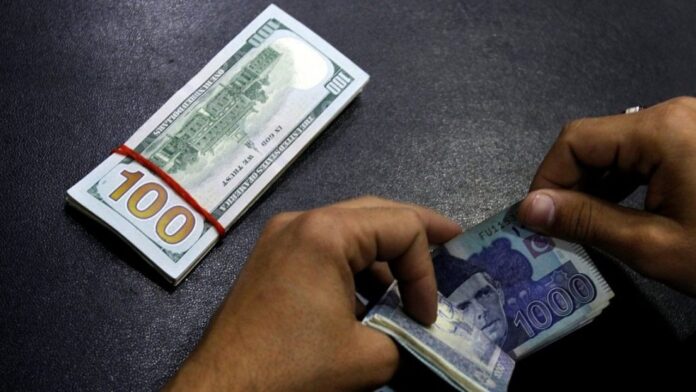KARACHI/LAHORE: The rupee lost 0.5215 paisas against the dollar and closed at Rs168.1895 per dollar on Monday after closing at Rs167.6680 per dollar on Friday in the interbank market.
The PKR hit an intraday high of Rs167.50, and a low of Rs168.30 against the US dollar.
Within the last year or so, the rupee was strongest on 17 February 2020, trading at Rs154.16 against the dollar, and the weakest on 27 March 2020, trading at Rs169.50.
“Although this is not the lowest the rupee has traded, there is a threat that the rupee can continue to slide further,” said Forex Association of Pakistan President Malik Bostan while talking to Profit.
EXTERNAL ACCOUNT
Bostan attributed this downtrend in PKR value to the global outbreak of Covid-19; a huge number of Pakistanis are now jobless and looking to return, which means remittances are on the lower side.
“Furthermore, export orders have been cancelled. Also, there is a surge in crude oil imports due to the lockdowns being eased. That too is money leaving the economy. The demand for the dollar is high, whereas the demand for the rupee is low. Regardless, the end of June is always a time of pressure on the rupee,” he explained.
Bostan opined, “In light of these pressures on the currency, the government is striving to attract inflows not only to strengthen reserves but also to boost its ability to meet their loan obligations that have been deferred due to coronavirus.”
Tresmark analyst Komal Mansoor informed that Pakistan had received $1.75 billion last week, following which the current account deficit became positive only for the second time this year. “Yet, the USD/PKR did not relent, staying within Rs167-Rs168 throughout.”
She stated, “Part of the answer lies in the closeout of forwards done by exporters. According to most estimates, a total of $1.3 billion closeouts have been done in the last four weeks, which has kept the rupee under continuous pressure.”
If everything else remains constant, she said, the closeouts will decrease after June 30th while exports are expected to increase, which means the rupee may gain value in the coming sessions.
“The demand for USD in the local market is high due to June-end payments. The pressure should ease off once planned inflows from commercial banks are materialized,” Samiullah Tariq, Head of Research & Development at Pak Kuwait Investment Company, noted.
Meanwhile, Renaissance Capital Global Chief Economist Charlie Robertson told Profit, “Beyond today, the PKR will be more affected by last week’s interest rate cut, which will reduce the relative attraction of holding rupees over dollars or euros.
The SBP likely sees an advantage in having looser interest rates and a cheap currency, to help support the economy,”
“We should get used to rupee hitting new lows now and then. However, do not expect any run on the currency. After the recent discount rate cut, speculators are expecting the rupee to depreciate and dollarization of the investments,” said Khadim Ali Shah Bukhari Securities Managing Director Arsalan Soomro.
INFLOWS/OUTFLOWS
“A loan of $500 million matured today; this is the likely cause of volatility in the rupee. On a cumulative basis, the maturity of $1.1 billion may be more this week,” explained Adnan Sheikh, a senior market analyst. “Despite receiving inflows of $1.7 billion, the rupee is still slipping, which shows that there is still the pressure of outflows.”
“The current account, multilateral inflows and exports’ resumption is going to keep the currency safe for now. Moderate day-to-day fluctuation is healthy and not necessarily a red/yellow flag. Currency is perhaps being kept here as an opportune time to give benefit to exporters, as regionally currencies are also under pressure,” explained Mr Soomro.
ATTACK ON PSX
Concerned quarters feel that the attack on the PSX may have pushed the dollar up against the rupee, despite the PSX indices recovering immediately in face of the attack.
However, Mr Robertson believed terrorism – especially unsuccessful terrorist attacks – tend to have only a very short-lived impact on a currency.
According to Chief Market Global Strategist at Axitrader, Stephen Innes, the rupee did not show the same resilience the PSX did. “Yes, the attack on the stock exchange heightened the risk at a bad time for the rupee. The dollar is not trading exceptionally stronger today so this could be the reason,” he added.

























“Tresmark analyst Komal Mansoor informed that Pakistan had received $1.75 billion last week, following which the current account deficit became positive only for the second time this year.”
Yeah… the positive current account numbers recently released were for May 2020, the $1.75 billion received last week will have no bearing on it.
The Dollar will close out FY20 @ around 165, or so say some bankers.
This dollars was Bigg celebration on Pakistani amount to 168 rupees